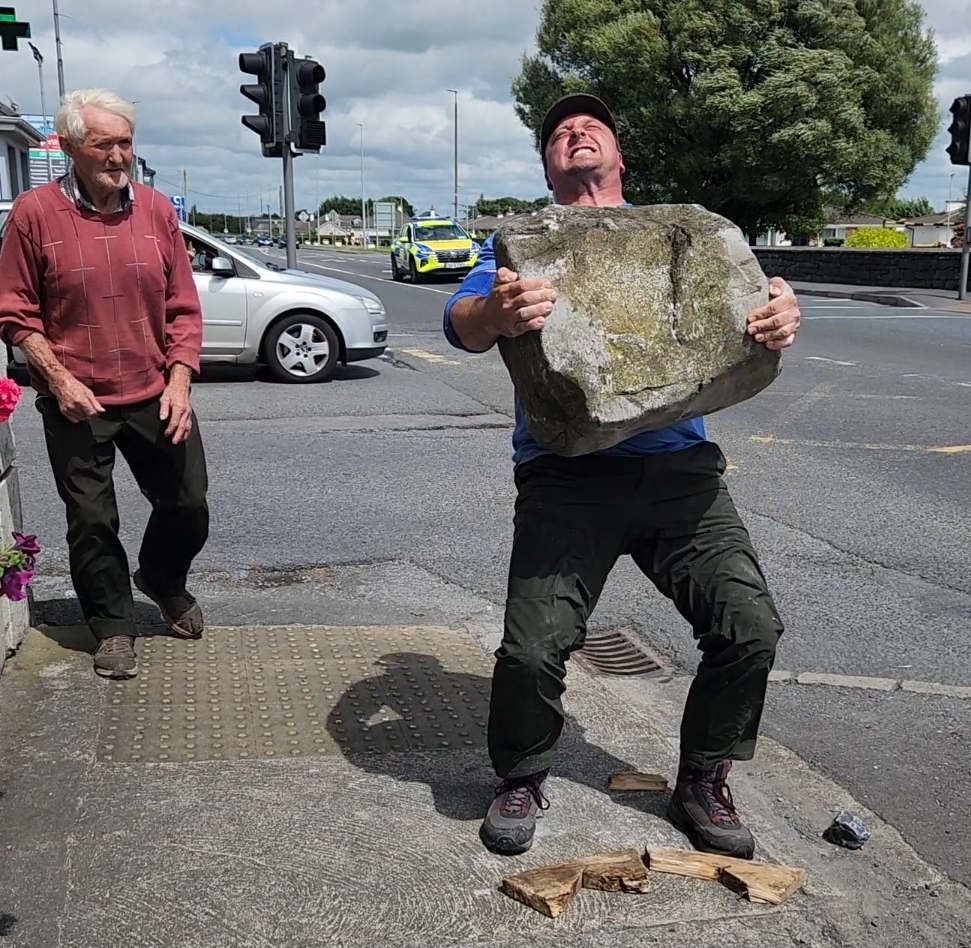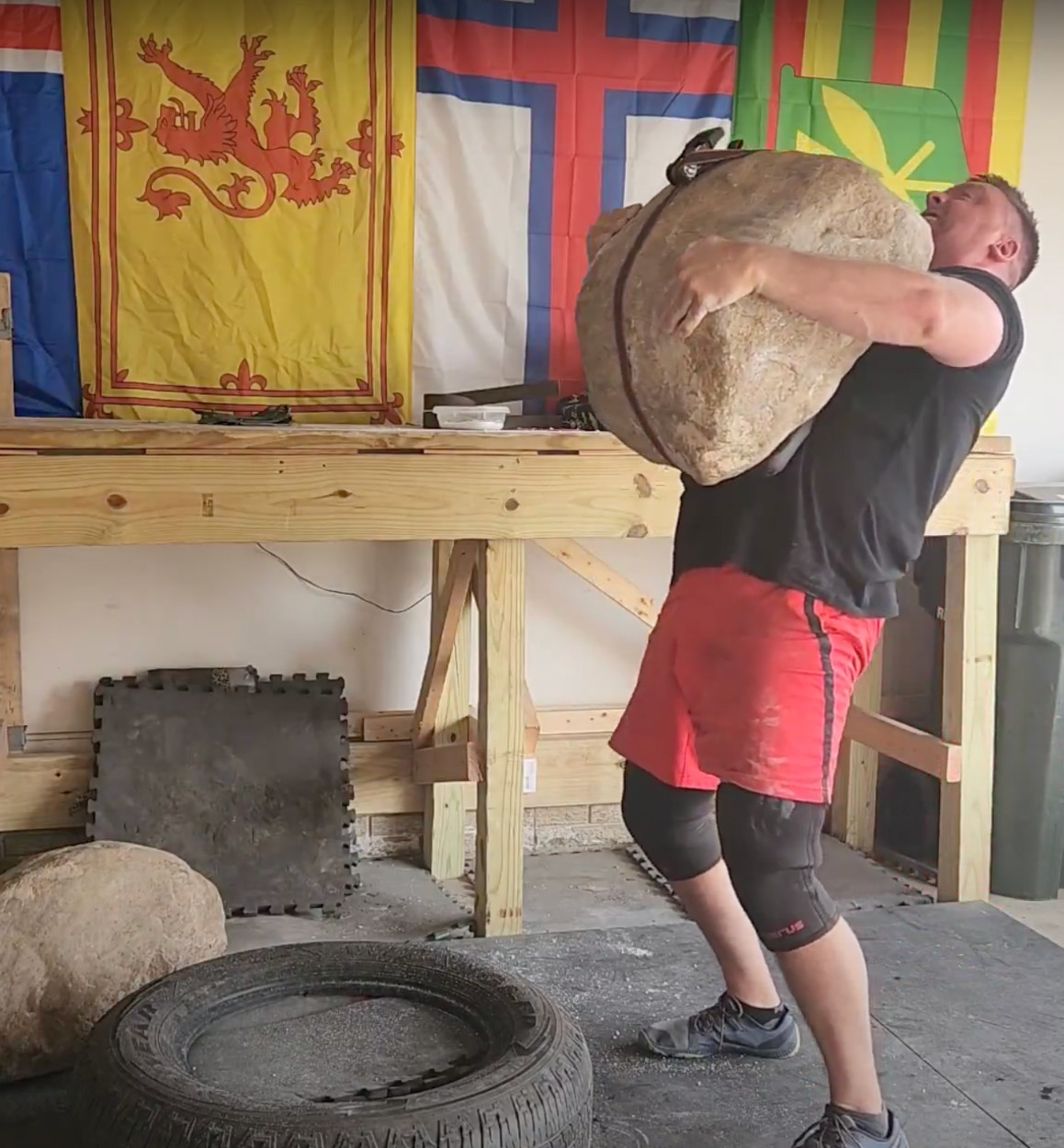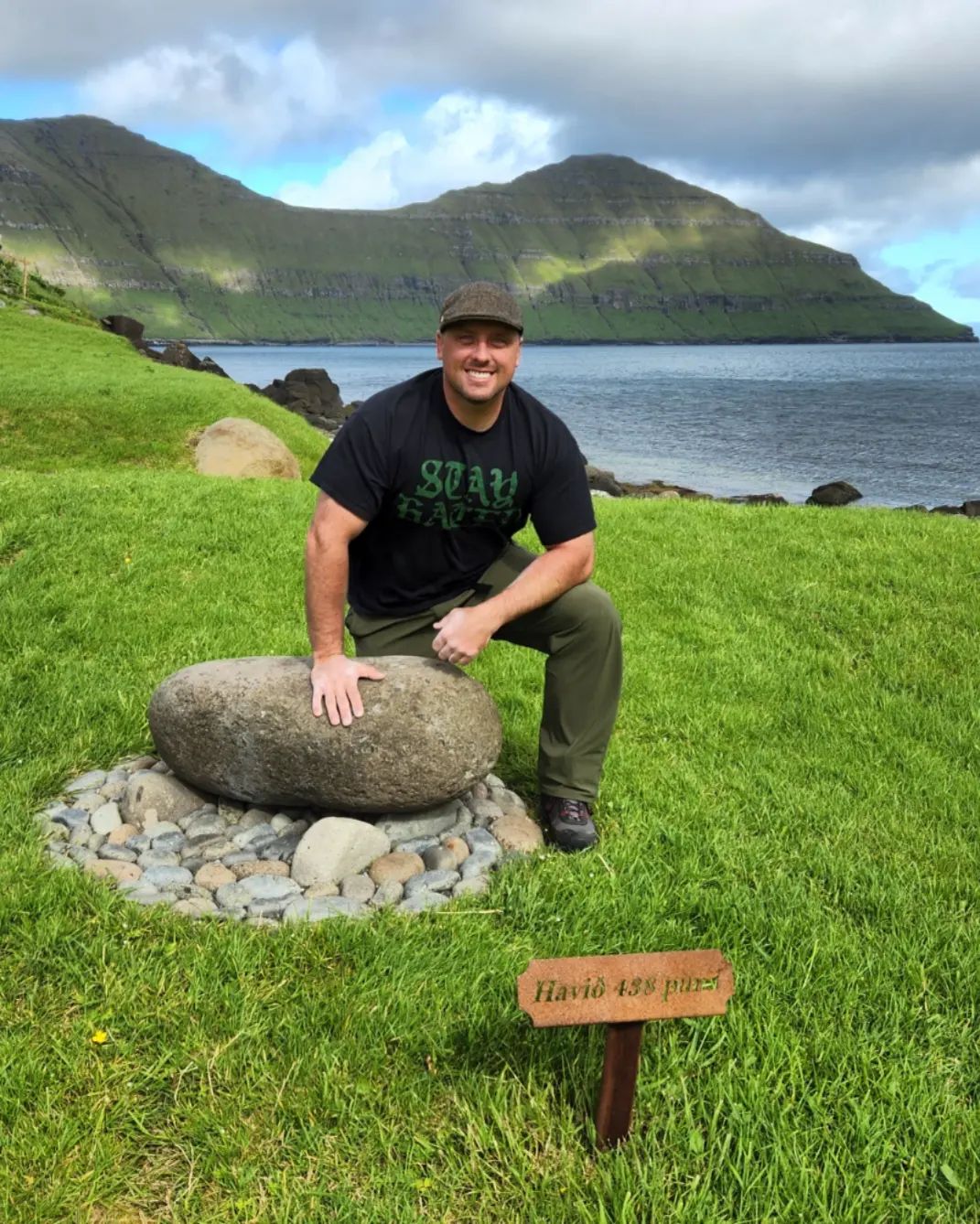Peaking for a stonelifting tour
Guest article by Sean Urquhart
Back in June, I completed my fourth overseas stone tour in Ireland. Although I only lifted 16 stones compared to the 30+ on each of my last two trips, the average weight and difficulty of these stones far exceeded my expectations. However, reflecting on my performance, I would say that this is likely my best stone lifting to date.
Of the stones I lifted in Ireland, 14 of the 16 were as heavy or heavier than Iceland’s Fullsterkur stones; imagine lifting the Húsafell stone multiple times a day, five days in a row. To say that the Irish stones took a toll on my body is an understatement. However, I feel that my detailed stone prep plan is what allowed me to be successful.
While on the trip, and old gentleman in his late 80s witnessed me lifting the Claregalway stone to my chest. Upon setting the stone down, he was left practically speechless. All he could muster was that he had never witnessed someone lift that stone so high in his lifetime and he didn’t think it would ever be possible if he hadn’t seen it for himself. That is proof enough for me that the program worked.

Whether you are planning a stone tour or just want to lift the biggest stone possible at your gym, I think this plan has what it takes to bring your stone lifting game up to the next level.
Notable lifts
During my prep for the Ireland tour, I achieved a few notable lifts:
- Camber bar box squat — 585 x 1 to 585 lbs x 2 reps
- Full stone lift to chest — 410 lbs stone + 30 lbs plate (heaviest stone to chest PR)
- Full stone lift to chest — 410 lbs stone x 3 extension reps (first time able to lift 410 stone for reps)
- Stone every 45 seconds — 320 / 345 / 370 / 395 for 8 total reps

Stone prep guide overview
This was my first time creating a plan and actually sticking to it. Usually, I would plan something out and then change it as I lift. I wanted to be more methodical in my approach this time, and it’s paying off as I feel stronger and more recovered every workout.
Waves are three weeks long, starting with higher volume on main lifts and lower volume on stones/accessories. As the weeks progress through the wave, the main lifts decrease in volume and increase in intensity. While the stones/accessories increase in volume and stay similar in intensity.
The total plan is three 3-week waves; 9 weeks worth of lifting. But it takes place over roughly 10.5 weeks.
For the main lift, intensity drives adaptation. For stones and accessories, volume drives adaptation. I could have chosen to drive adaptation through intensity for all exercises, but I felt like that would be a fast track towards injury and burnout. I wanted to avoid both at all costs leading up to the stone trip.
At the end of a 3-week wave, I take a mini deload on the upper and lower speed days — so not a week-long deload like many people recommend. This is more of a reset so that I am ready to go again for my next wave.
The final wave is the taper which is designed to help me demonstrate my strength on the stone tour.
Work capacity
The plan here was to build work capacity with a higher volume of main lifts and accessories. This would allow me to feel fresher when lifting stones and to lift heavier stones each week without feeling like the stones were burning me out.
In the past, my stone volume was extremely high. This worked well for trips where I needed to lift more than 30 historic stones, but it took its toll on my recovery and usually left me feeling beat up for the duration of my prep.
Building work capacity with barbell work is much easier to regulate compared to stones; I can adjust sets, reps, and weight, but I can’t do that as easily with a stone. This approach worked very well throughout the prep for Ireland — I just wish I had thought of this sooner in my earlier stone trip preps!
Max effort
Traditionally, I would work up to one heavy top set, which worked great for learning to strain and fight through a lift. But with my plan to build work capacity while lifting lower stone volume than normal, I had to make a change here. As a result, I chose to make max effort into heavy submaximal effort for multiple sets of low reps.
Training with heavy submaximal effort meant I could still train heavy but also acquire the volume I was looking for to build the work capacity I wanted for multiple heavy stone lifts without such high volume on stones.
Each week, the volume decreases for the main lift while intensity increases. An inverse relationship between stone and squat volume each week makes up for the drop in volume on the main lift.
Intensity was adjusted using a step loading method from wave to wave:
- 5x3 @ 495 (~85%) / 3x3 @ 515 (~88%) / 1x3 @ 535 (9 RPE)
- 5x2 @ 515 (~88%) / 3x2 @ 535 (~91%) / 1x2 @ (9 RPE)
- 5x1 @ 535 (~91%) / 3x1 @ 555 (~94%) / 1x1 @ (9 RPE)
Dynamic effort
Dynamic effort did not change much for this prep from what I normally do in training. The biggest difference was keeping the same movement throughout the entire 9-week prep like I did for the max effort movement.
Intensity and volume maintained the inverse relationship to what is normally prescribed. I chose to use step loading from wave to wave:
- 10x2 @ 55%/ 8x2 @ 60%/ 6x2 @ 65%
- 10x2 @ 60%/ 8x2 @ 65%/ 6x2 @ 70%
- 10x2 @ 65%/ 8x2 @ 70%/ 6x2 @ 75%
Stones
When preparing for previous trips, I lifted stones three times per week on a Heavy – Light – Medium schedule. During the Ireland trip, I would be lifting fewer stones (roughly 15-20) than previous trips (30 and 35 stones), and the average weight lifted to chest would be higher this time, too.
To compensate for fewer stones and greater weights, I felt that the third (light) day for stones was unnecessary. Instead, I opted to build volume through barbell work and focus on bringing up the lifts that I knew translated to heavier stone lifts. I also chose to reduce the volume and weight of stones lifted on my lower body speed days.
For my previous trip, I lifted my 370 lbs stone and 425 lbs Hav on speed days. This time, I primarily lifted my 345 lbs stone and occasionally my 370 lbs stone. Since I lowered the intensity and volume of stone lifts on speed days, I wanted to make sure that I still challenged myself. To do this, I decreased the rest periods between sets.
Previously, I would rest as needed, but this time around, I used a timer and performed EMOM sets, lifting the 345 lbs stone one rep every minute on the minute. This proved to be a great workout, and I felt muscles in my back that I wouldn’t normally feel lifting even heavier stones with longer rest periods.
Word to the wise: natural stones are a pain in the butt to reset for the next lift when training alone on limited rest. That 50 seconds you thought you had quickly turns into 30.
If you have the luxury of a training partner, this would be a great time to have them assist in resetting the stone. Otherwise, increase the rest from 60 seconds to something more manageable like, 70 seconds. As your conditioning improves, you can easily decrease the rest back to 60 seconds or even less. By the end of my prep, I was completing stone lifts with 45 seconds on the clock.
I was gassed the first time I performed these EMOM sets. By the third week, I looked forward to the challenge and even increased the weight of the stone to 370 lbs. Throughout the prep I kept thinking of how great the challenge would be to lift my 410 lbs stone for a 10-minute EMOM. This may be something that I visit in the future, but pushing that kind of intensity before the trip would quickly lead to unnecessary fatigue and diminished recovery.
Heavy days remained similar to previous stone trip preps, with two small changes. For the first change, I reduced volume from about 12 lifts down to an average of 6 and increased the volume on each week of the wave:
- Week 1: 4 lifts
- Week 2: 6 lifts
- Week 3: 8 lifts
The second change I made was to drop back down to 4 lifts on the following wave, but to try and increase the intensity of the stone lift. I would either add weight with ratchet straps and steel plates or increase the number of stone extension reps for each lapped rep.
Certain stone shapes made adding weight very easy. For those I kept the lifts to single reps. Other stone shapes were more difficult to add weight, so I increased the number of extensions that I performed each time I lapped the stone.
For example, week 1 – lap the stone perform 2 extensions per lift, week 2 – lap the stone perform 3 extensions per lift, week 3 – lap the stone and perform as many extensions as possible on the last lift.
If I chose to work with my 410 lbs stone and increase extensions per lap, I would not increase the number of total lifts from 4 to 6 to 8 over the wave. I would instead stay with 6 lifts each week but increase the extensions instead.
All of this was focused on building intensity from week to week and wave to wave while maintaining my ability to recover and progress. I easily could have increased all those things from week to week, but eventually I would have hit a wall that wouldn’t allow me to recover. My focus was to be successful on my stone trip, not to lift the largest stone I could in my garage.
Exercise selection
I chose to stick with the same lifts throughout the 3-week waves on upper and lower body. I wanted to be as specific as possible with my exercise choices, opting for variations that I knew had good carryover to my stones and where I could easily manage fatigue. I also needed exercises that I knew my relative max so that I could easily plan my weights from week to week without any uncertainty that I would miss a lift. This was important since my max effort work was now submaximal effort for multiple sets of low reps.
How would I know that I was getting stronger if I only tested each exercise variation once every few months? By changing my methods, I could get weekly feedback on my progress. For example, my first wave I squatted 535 lbs for 3 reps on my last week of the wave, which only has one top set. It wasn’t a true max effort, but a 4th rep would’ve been a real grind. On my second wave, I squatted 535 lbs for 5 reps after completing two sets of doubles. I had instant feedback that my program was working. This was 9 total reps with 535 lbs that were all easy and allowed for recovery whereas my previous wave was 3 total reps with 535 lbs and left me feeling drained.
Tapering
Over the first two waves, I gradually built up the intensity of the main lifts while decreasing volume. For accessories and stones, I kept intensity relatively level while increasing volume. Each wave’s intensity was higher than the last, but volume reset at the start of each wave.
For the final wave of my training block, I needed to make sure I could display the strength I developed over previous waves to peak for my trip to Ireland. How did I do this? The key was to decrease the fatigue I had accumulated from the last two waves. There is plenty of research on this topic, and the consensus is this: Strength can be maintained by keeping intensity high while reducing volume. i.e., fatigue decreases and allows us to display our strength.
High volume is one of the best ways to accumulate fatigue — something we are actively trying not to do during the taper. One thing that will be out of my norm is overreaching a little bit on the first week of the taper with higher-than-normal volumes at a high intensity. The focus of this is a bit of a supercompensation. The thinking is that the fitness developed will be maintained longer by reaching your limits of recoverability right before dropping the volume for the taper. I probably will ruffle some feathers by suggesting people still lift heavy weights and stones so close to a stone trip (10 days out heaviest squat/stones and 7 days out speed squat/stones) but I feel that this works well for me.
Some people will completely deload from lifting for the week before a trip. I don’t think that works well for a stone trip as we are not maxing out on a lift like you would in a powerlifting meet. We’re still lifting heavy, but most of the stone lifts (at least for what I have found) are not max effort lifts.
How does this taper look on paper?
- Intensity stays high on the main lift, supplemental lift, and stone lifts
- Volume drops for the main lift and supplemental lift, following the same progression as previous waves
- Volume for stone lifts decreases over the course of the wave
- No longer maxing out or taking final sets close to failure
- Final max testing is 4 weeks before the trip at the end of wave 2
- Volume for accessory work is the reverse of previous waves
- 5 sets – 4 sets – 3 sets instead of 3 sets – 4 sets – 5 sets
The next step is to put it all of these concepts together into their waves to build the full training block. The free downloadable ebook has my full 3-wave training plan (including the taper), as well as additional insight into my upper-body and goodmorning training leading up to my Ireland tour.
Author
Sean Urquhart is one of the top stonelifting researchers and lifters in the world. In 2023, Sean was part of the first stonelifting tour of Ireland where he lifted some of the heaviest stones of his career.

Contributions
With massive thanks to Sean for sharing his expertise! You can follow him on Instagram.
Read the liftingstones.org letters
Join thousands of other stonelifters who read the world's most popular stonelifting newsletter.